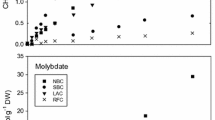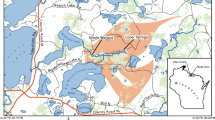Abstract
Anoxic salt marsh sediments were amended with several methylated sulfur compounds. Sediment microbes transformed the added compounds into other volatile methylated sulfur compounds and eventually mineralized the compounds to CH4 and presumably to CO2 and H2S. The principal methyl-sulfur product of dimethylsulfoniopropionate (DMSP) was found to be dimethylsulfide (DMS), with only small amounts of methane thiol (MSH) produced. By contrast, methionine and S-methyl cysteine were degraded mostly to MSH and to lesser amounts of DMS. Dimethylsulfoxide (DMSO) was biologically converted to DMS. Dimethyldisulfide (DMDS) was rapidly reduced to MSH by the sediment microflora, and some DMS was also produced. DMS, whether added directly or when derived from other precursors, was metabolized with the production of MSH. Methane thiol was also metabolized, and evidence suggests that MSH may be biologically methylated to form DMS. Experiments with selective microbial inhibitors were used to ascertain which microbial groups were responsible for the observed transformations. Based on these experiments, it appears that both sulfate-reducing and methane-producing bacteria may be involved in transforming and mineralizing methylated sulfur compounds. A simple scheme of how methylated sulfur compounds may be transformed in the environment is presented.
Similar content being viewed by others
References
Adams DF, Farwell SO, Robinson E, Pack MR, Bamesberger WL (1981) Biogenic sulfur source strengths. Environ Sci Technol 15:1493–1498
Andreae MO (1980) Dimethyl sulfoxide in marine and fresh waters. Limnol Oceanogr 25: 1054–1063
Andreae MO, Barnard WR (1984) The marine chemistry of dimethyl sulfide. Mar Chem 14: 267–279
Andreae MO (1985) Dimethylsulfide in the water column and the sediment porewaters of the Peru upwelling area. Limnol Oceanogr 30:1208–1218
Aneja VP, Overton JH, Cupitt LT, Durham JL, Wilson WE (1979) Direct measurements of emission rates of some atmospheric biogenic sulfur compounds. Tellus 31:174–178
Banat IM, Nedwell DB (1984) Inhibition of sulfate reduction in anoxic marine sediment by Group VI anions. Estuarine, Coastal, and Self Science 18:361–366
Bechard MJ, Rayburn WR (1979) Volatile organic sulfides from freshwater algae. J Phycol 15:379–383
Bilous PT, Wiener JH (1985) Dimethyl sulfoxide reductase activity by anaerobically grownEscherichia coli HB101. J Bacteriol 162:1151–1155
Bremner JM, Steele CG (1978) Role of microorganisms in the atmospheric sulfur cycle. In: Alexander M (ed) Advances in microbial ecology. Plenum Press, New York, pp 155–201
Challenger F (1959) Aspects of the organic chemistry of sulfur. Butterworths, London
Compeau GC, Bartha R (1985) Sulfate-reducing bacteria: principal methylators of mercury in anoxic estuarine sediments. Appl Environ Microbiol 50:498–502
Dacey JWH, Wakeham SG, Howes BL (1984) Henry's Law constants for dimethylsulfide in freshwater and seawater. Geophys Res Lett 11:991–994
Gunsalus RP, Roemesser JA, Wolfe RS (1978) Preparation of coenzyme M analogues and their activities in the methyl coenzyme M reductase system ofMethanobacterium thermoautotrophicum. Biochemistry 17:2374–2377
Hahn FE (1967) Chloramphenicol. In: Gotlieb D, Shaw PD (eds) Antibiotics I. Mechanisms of action. Springer-Verlag, New York, pp 309–330
Howes BL, Dacey JWH, Wakeham SG (1985) Effects of sampling technique on measurements of pore water constituents in salt marsh sediments. Limnol Oceanogr 30:221–227
Kiene RP, Capone DG (1984) Effects of organic pollutants on methanogenesis, sulfate reduction and carbon dioxide evolution in salt marsh sediments. Mar Environ Res 13:(2)141–160
Kiene RP, Capone DG (1985) Degassing of pore water methane during sediment incubations. Appl Environ Microbiol 49:143–147
Kiene RP, Oremland RS, Catena A, Miller LW, Capone DG (1986) Metabolism of reduced methylated sulfur compounds by anaerobic sediments and a pure culture of an estuarine methanogen. Appl Environ Microbiol 52:1037–1045
Mopper K, Taylor BF (1986) Biogeochemical cycling of sulfur: thiols in marine sediments. In: Sohn M (ed) Organic marine geochemistry. ACS symposium series no. 305. American Chemical Society, Washington, DC
Nanninga HJ, Gottschal JC (1986) Isolation of a sulfate-reducing bacterium growing with methanol. FEMS Microbiol Ecol 38:125–130
Oremland RS, Taylor BF (1978) Sulfate reduction and methanogenesis in marine sediments. Geochim Cosmochim Acta 42:209–214
Przyjazny A, Janicki WA, Chrzanowski W, Staszewski R (1983) Headspace gas Chromatographic determinations of distribution coefficients of selected organosulfur compounds and their dependence on some parameters. J Chromatogr 280:249–260
Rasmussen RA (1974) Emission of biogenic hydrogen sulfide. Tellus 26:254–260
Ridley WP, Dizikes LJ, Wood JM (1977) Biomethylation of toxic elements in the environment. Science 197:329–332
Salsbury RL, Merricks DL (1975) Production of methane thiol and dimethyl sulfide by rumen microorganisms. Plant Soil 43:191–209
Segal W, Starkey RL (1969) Microbial decomposition of methionine and identity of resulting sulfur products. J Bacteriol 98:908–913
Slater J, Capone DG (1984) Effects of metals on nitrogen fixation and denitrification in slurries of anoxic saltmarsh sediment. Mar Ecol Prog Ser 18:89–95
Steudler PA, Peterson BJ (1984) Contribution of gaseous sulfur from salt marshes to the global sulfur cycle. Nature 311:455–457
Taylor BF, Oremland RS (1979) Depletion of adenosine triphosphate inDesulfovibrio by oxyanions of group VI elements. Curr Microbiol 3:101–103
Tocher CS, Ackman RG (1966) The identification of dimethyl-β-propiothetin in the algaeSyracosphaem carterae andUlva lactuca. J Biochem 44:519–522
Vairavamurthy A, Andreae MO, Iversen RL (1985) Biosynthesis of dimethyl sulfide and dimethyl propiothetin byHymenomonas carterae in relation to sulfur and salinity variations. Limnol Oceanogr 30:59–70
Wakeham SG, Howes BL, Dacey JWH (1984) Dimethyl sulfide in a stratified coastal salt pond. Nature 310:770–772
Zehnder AJB, Zinder SH (1980) The sulfur cycle. In: Hutzinger O (ed) The handbook of environmental chemistry. Vol. 1/part A. Springer-Verlag, Berlin, Heidelberg
Zinder SH, Brock TD (1978) Production of methane and carbon dioxide from methane thiol and dimethyl sulfide by anaerobic lake sediments. Nature 273:226–228
Zinder SH, Brock TD (1978) Methane, carbon dioxide and hydrogen sulfide production from the terminal methiol group of methionine by anaerobic lake sediments. Appl Environ Microbiol 35:344–352
Zinder SH, Brock TD (1978) Dimethyl sulfoxide as an electron acceptor for anaerobic growth. Arch Microbiol 116:35–40
Zinder SH, Brock TD (1978) Dimethyl sulfoxide reduction by microorganisms. J Gen Microbiol 105:335–342
Zinder SH, Doemel WN, Brock TD (1977) Production of volatile sulfur compounds during the decomposition of algal mats. Appl Environ Microbiol 34:859–860
Author information
Authors and Affiliations
Rights and permissions
About this article
Cite this article
Kiene, R.P., Capone, D.G. Microbial transformations of methylated sulfur compounds in anoxic salt marsh sediments. Microb Ecol 15, 275–291 (1988). https://doi.org/10.1007/BF02012642
Issue Date:
DOI: https://doi.org/10.1007/BF02012642




